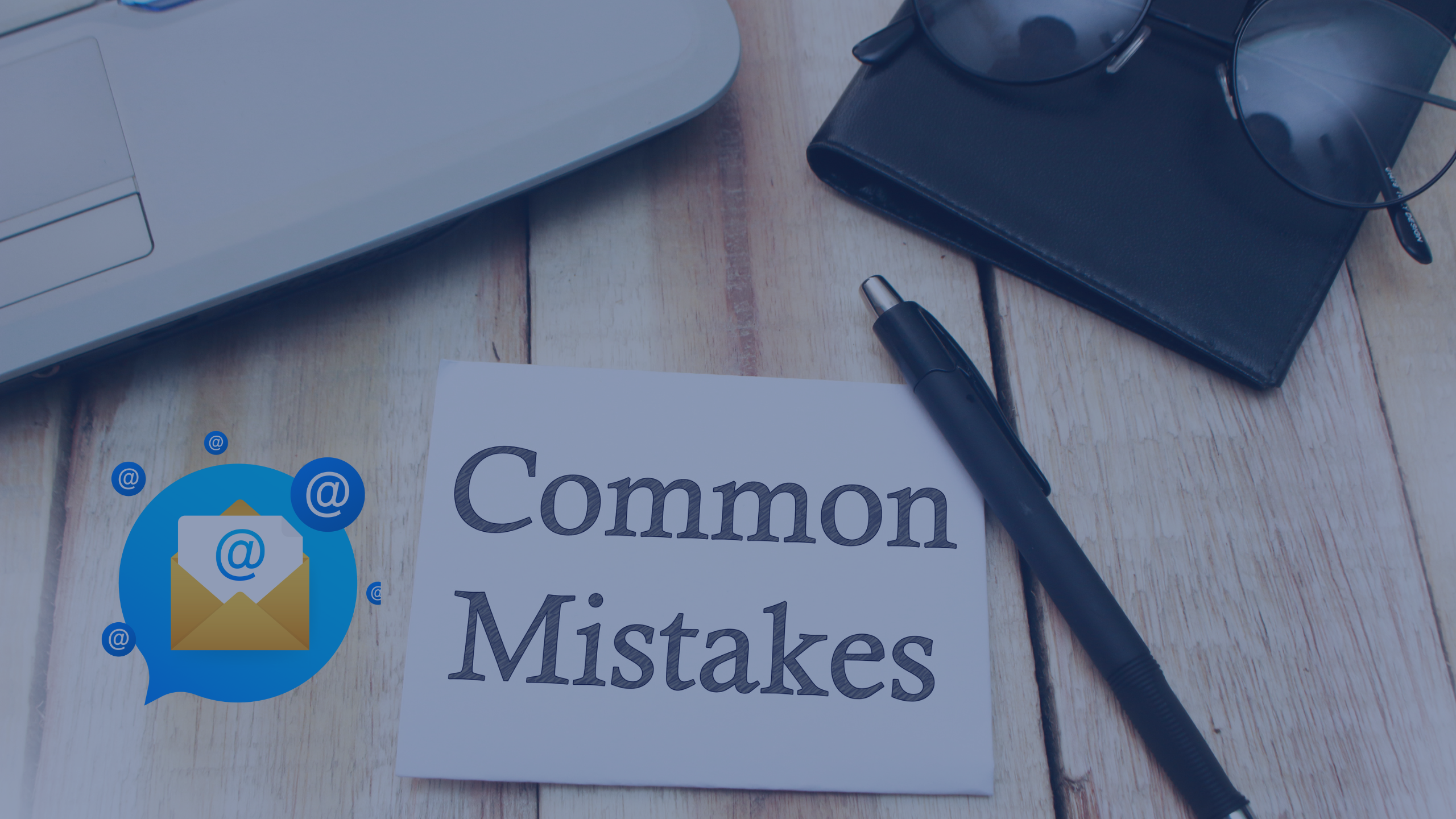5 Common Email Marketing Mistakes To Avoid
A potent technique for connecting with and interacting with clients is email marketing. It enables companies to communicate with a broad audience in a targeted and individualized way, which may enhance sales and client retention. Avoiding frequent errors, on the other hand, may help ensure that your email marketing initiatives are successful.
Here are 5 frequent email marketing blunders to steer clear of. These include failing to segment your email list, failing to optimize for mobile, failing to test your emails, failing to use a call-to-action that is obvious, and failing to evaluate and modify your approach. You may enhance the outcomes of your email marketing efforts by comprehending and avoiding these errors.
Mistake #1: Not segmenting your email list
Not segmenting your email list is one of the most frequent mistakes made in email marketing. The act of segmenting involves separating your email list into more manageable groupings according to particular traits or habits. This enables you to deliver each group more individualized and targeted communications, which may increase engagement and conversion rates.
Your email list may be segmented in a variety of ways. Several instances include:
- Demographic segmentation: dividing your list based on characteristics such as age, gender, location, and income.
- Behavioral segmentation: dividing your list based on actions or behaviors, such as email open rate, purchase history, and website engagement.
- Interest-based segmentation: dividing your list based on interests, such as specific product categories or content topics.
You may develop more engaging messages that resonate with your audience by segmenting your email list. You may send customized advertisements offering comparable items to consumers who have previously purchased a given product, for instance, if you split your list according to to buy history.
Overall, segmentation is a crucial component of email marketing that may boost effectiveness. Understanding the various list segmentation options and using them in your campaigns can improve your chances of success.
Mistake #2: Not optimizing for mobile
Mobile devices have become a crucial component of email marketing in the current digital era. It is crucial to optimize your emails for mobile devices since more and more people use their email on smartphones.
Lack of mobile optimization can result in a variety of problems, including a bad user experience, low open and click-through rates, and even the chance that your email could be flagged as spam.
There are a few important considerations to make in order to mobile-optimize your emails:
- Use a responsive design that automatically adjusts to the size of the screen.
- Keep your subject lines short and to the point, as they may be truncated on mobile devices.
- Use a simple and clear layout, with a single-column design.
- Make sure your call-to-action buttons are large and easy to tap.
- Keep images to a minimum, and make sure they are optimized for mobile.
In addition to the technical considerations, it's critical to take into account the context of how mobile consumers will read your emails. Try to be as precise and succinct as you can because they could be rushing or on the go.
You can make sure that your audience sees and responds to your message by making your emails mobile-friendly. You may boost the likelihood that your audience will open, read, and respond to your emails by using the aforementioned advice.
Mistake #3: Not testing your emails
The effectiveness of your email marketing initiatives depends on testing your emails before distributing them to a bigger audience. It enables you to find and fix any problems before they affect a larger audience, which may increase open and click-through rates.
Before sending your emails to your full list, there are a few things you should test. Several instances include:
- Subject lines: Test different subject lines to see which one gets the highest open rate.
- Personalization: Test the use of personalization elements such as the recipient's name or location to see if it improves engagement.
- Call-to-action buttons: Test different text, placement, and design of the call-to-action button to see which one gets the most clicks.
- A/B testing: Test different variations of your email to see which one performs better.
- Email client testing: Test your email on different email clients such as Gmail, Outlook, Yahoo, etc to ensure they look good on all of them.
It's also crucial to test your emails on various gadgets, including desktop computers, tablets, and smartphones. This can assist you in finding any problems that could occur while viewing your emails on various devices.
You may learn a lot about what works and what doesn't by testing your emails, and you can use this knowledge to make your email marketing campaigns more effective. Your audience will receive and act on your emails if you have a solid testing strategy in place.
Mistake #4: Not using a clear call-to-action
Any email marketing campaign must have a call-to-action (CTA). It is a button or link that entices the user to perform a certain action, such as visiting a website, buying something, or subscribing to a newsletter. A call-to-action, however, might be misunderstood by the recipient or fail to be recognized if it is not executed properly.
Your call to action must be obvious and simple to discover in order to be effective. The following are some pointers for creating an effective call to action:
- Use action-oriented language: Use words such as "buy," "register," "Subscribe," and "download."
- Make it prominent: Make the call-to-action button or link stand out by using contrasting colors, making it larger than other elements, or placing it in a prominent location.
- Keep it simple: Avoid using too many CTAs in an email or making them too complex. Keep it simple and direct.
- Use urgency: Create a sense of urgency by using phrases such as "limited time offer" or "act now."
- Test different versions: Test different versions of your CTA to see which one gets the most clicks.
A successful email campaign may be distinguished from one that falls short of expectations by a clear and compelling call to action. You may boost the likelihood that your audience will perform the required action by paying attention to these suggestions.
Mistake #5: Not analyzing and adjusting your strategy
For your email marketing plan to function better, it is essential to analyze the results of your email campaigns. It is challenging to determine what works and what doesn't, and to decide on future efforts, without evaluating the data and metrics.
You should monitor important metrics like the open rate, click-through rate, conversion rate, and bounce rate to evaluate the effectiveness of your email marketing. These metrics will provide you with a clear picture of how your emails are doing overall and show you where you need to make changes.
Once the data has been gathered and examined, you can utilize it to enhance your email marketing approach. Using data and analytics to enhance your plan can help you with the following:
- Identify patterns: Look for patterns in the data, such as which days of the week have the highest open rates or which subject lines get the most clicks.
- Test and optimize: Use the data to test and optimize different elements of your emails, such as subject lines, personalization, and call-to-action buttons.
- Segment your audience: Use the data to segment your audience and send more targeted and personalized messages.
- Re-engage inactive subscribers: Use the data to identify inactive subscribers and re-engage them with targeted campaigns.
You may continuously boost the effectiveness of your email marketing and get greater results by reviewing and modifying your approach. You may make data-driven decisions that will assist you in achieving your email marketing objectives if you have the appropriate data and analytics solutions in place.
Email marketing is an excellent tool for connecting with and interacting with clients, but it's crucial to avoid typical blunders that might reduce the efficacy of your efforts.
In this post, we covered 5 major blunders to avoid, including failing to segment your email list, failing to optimize for mobile, failing to test your emails, failing to use a clear call-to-action, and failing to analyze and modify your approach.
You may enhance the outcomes of your email marketing efforts by comprehending and avoiding these errors.
A clear and effective call-to-action can make the difference between an email campaign that exceeds expectations and one that falls short, while segmenting your email list enables you to send more targeted and personalized messages, optimizing for mobile ensures that your message is seen and acted upon by your audience, and testing your emails before sending them to the larger audience allows you to identify and address any issues before they reach a wider audience.
There are several internet tools, including blogs, webinars, and e-books, for anyone who wishes to learn more about email marketing. In addition, a number of email marketing platforms provide courses and recommendations to assist firms in strengthening their email marketing initiatives. You can keep enhancing your email marketing plan and get greater results by looking for these tools.











